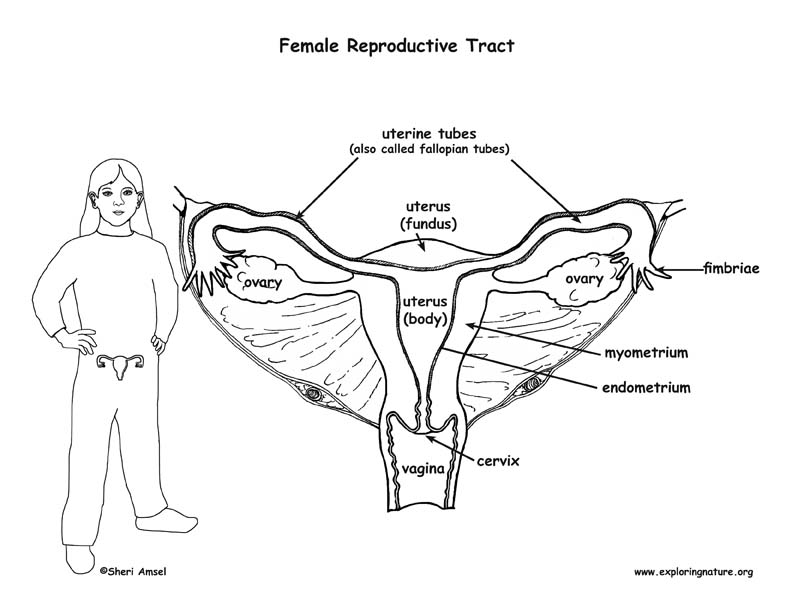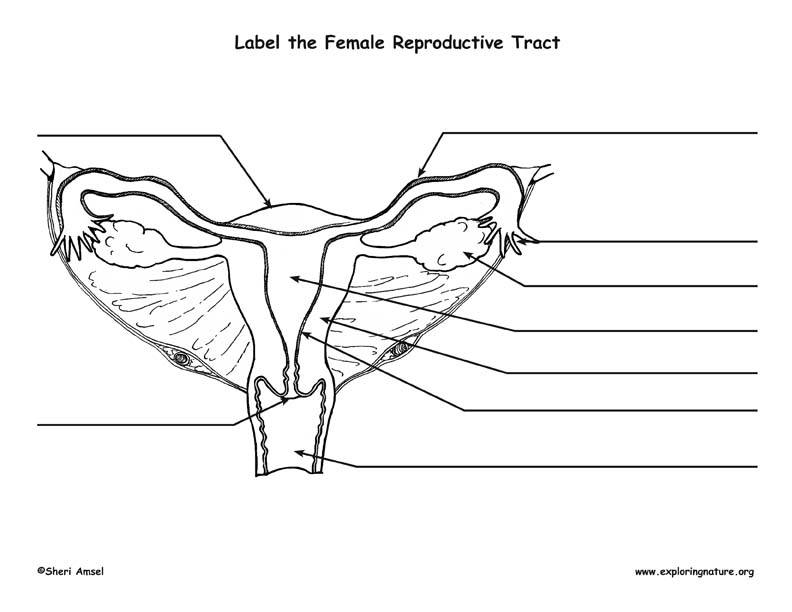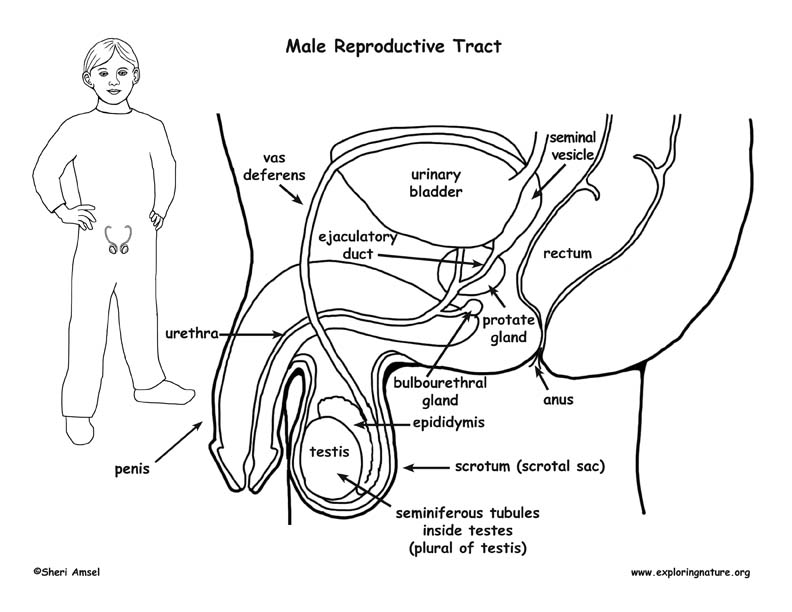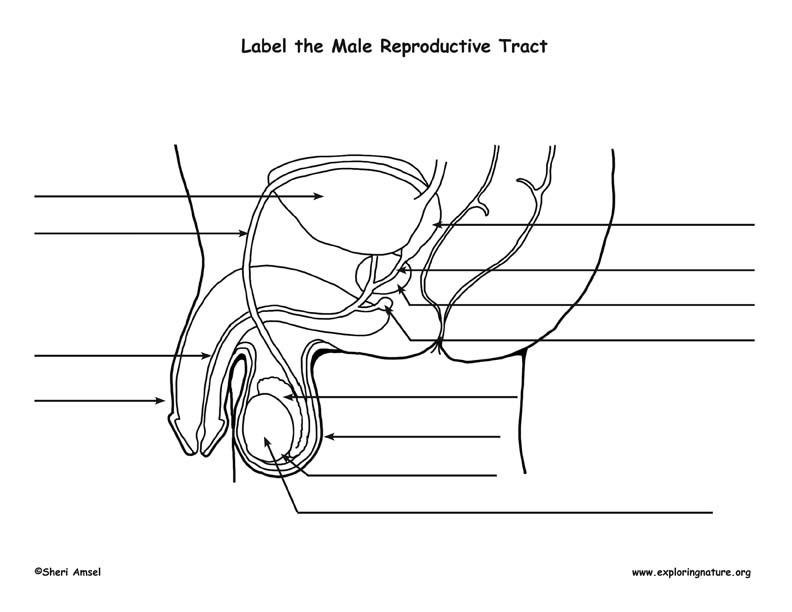

Female Reproductive System
In girls, the primary sex organs are the two ovaries. The ovaries release the eggs. They are also endocrine glands that make the hormones estrogen and progesterone. The accessory sex organs include the uterus, uterine tubes (also called fallopian tubes), which bring the egg to the uterus, and the vagina. These organs deliver the egg and create an environment for the sperm and egg to unite to grow a baby.
The ovaries are each about the size of an almond and sit on either side of the uterus in the abdomen. A girl is born with all the eggs she will ever have in her two ovaries. She does not make any more eggs in her lifetime the way a boy makes sperm throughout his life. A girl’s ovaries may have as many as 700,000 eggs in them when she is born, but she will only release about 500 in her whole lifetime.
When a girl reaches puberty at between 10-15 years old, the ovaries will begin to release the hormones estrogen and progesterone. These hormones will wake up the reproductive system and many things begin to happen.
When puberty is complete, a girl has reached her adult form.
When an egg is released from the ovaries each month, it is called ovulation. At ovulation, the egg is gathered up by the fimbriae into the uterine tube where it travels down into the uterus. The uterus prepares itself for a fertilized egg every month, it’s inner wall, called the endometrium, ready to receive and implant it.
If the egg is fertilized by a sperm, it happens in the uterine tube before it reaches the uterus. Then it will implant in the wall of the uterus and begin to develop into a fetus. A girl’s reproductive system is much more complicated than a boy’s because her body will hold and care for a growing baby if one of her eggs is fertilized. If the egg is not fertilized, the endometrium layer of the uterus will begin to break down and another menstrual cycle will begin.
Every 28 days, a woman goes through a complete menstrual cycle. There are several phases of the menstrual cycle. This is roughly how they work, though they can be slightly different for every woman.
This marks the end of one menstrual cycle. Then it will start all over again.
Pregnancy or gestation period is the time between fertilization and the birth of the baby. That first cell that results from a sperm and egg getting together at fertilization is called a zygote. It contains half of its genetic from each parent. The zygote grows over the next few weeks into an embryo. At nine weeks it is called a fetus. After 280 days (and birth) this single cell has become an infant.
For the nine months after fertilization, this cell lives and grows inside the uterus of the pregnant woman. Many things happen during that time. While it grows and develops, it gets all its oxygen and food from the mother through the placenta. The placenta is an organ that only develops during pregnancy. Through the placenta, a developing baby gets a little bit of anything the woman takes into her body. This includes oxygen, food and even medicine. This is why pregnant women have to be very careful. Alcohol, drugs, and even illnesses, like measles, during pregnancy can get through her bloodstream and affect the growing baby. During the nine months of pregnancy, the woman’s body is changing too. For the first three months she may experience a queasy feeling, especially in the morning. This is referred to as morning sickness and is common among pregnant women.
Over the next few months, the fetus grows and pushes the internal organs aside. At night, when the woman is lying down, the baby can press down on her stomach, bladder and intestines and make her uncomfortable. She may have to urinate more often. Some foods won’t taste good and she may not be able to eat much at one time. Her breasts will grow in preparation for feeding the baby. By the end of the pregnancy, her feet may be swollen and she may be pretty tired. Pregnancy can be hard on a woman’s body. After nine months, the baby is fully developed and ready to be born. The muscular layer of the uterus – the myometrium contracts to push the baby out into the world. A woman’s first birth can take at least 14 hours of labor before the baby is ready to be delivered.
When the baby is born, it takes its first breath and its lungs open up and start to work. The placenta, which was attached to the baby through the belly button, can then be separated from the baby. Now that it is separate from its mother, the baby will get hungry. The mother’s breasts, stimulated by hormones, start to make milk and soon after the birth she can begin to breastfeed her new baby.
Testing:
Female Reproductive System Vocabulary Quiz
*Labeling Pages included in PDF at bottom.
Male Reproductive System
The organ systems of the body are working all the time from birth to death to keep the body in homeostasis (balance) – except for the reproductive system. The reproductive system doesn’t start to work at full speed until puberty.
The organs of the reproductive system include a pair of primary sex organs and their accessory sex organs, such as glands, ducts and the sex organs on the outside of the body – the external genitalia or genitals.
Puberty is the process where sex hormones are released and begin to act on the sex organs until they become fully developed. This phase of life is also called adolescence. When a person reaches sexual maturity, they can then have children of their own. The age that puberty begins and how long it lasts varies from person to person.
In boys, the primary sex organs are the two testes (also called the gonads or testicles). The testes make sperm (or spermatozoa). They are also endocrine glands and make the hormone testosterone. All other sex organs – the other glands, ducts and the penis are accessory sex organs and act to protect the sperm and deliver it to the egg for fertilization. Fertilization is when a female’s egg is made ready by a male’s sperm to make new offspring.
The testes are protected by two fibrous layers with a tough outer sac called the scrotum. Inside, the testes are made up of long, coiled seminiferous tubules in which the sperm are made. Outside of the testes, but still inside the protective scrotum, is another coiled tube called the epididymis. This is where sperm that are made in the testes are stored and mature. After a boy passes through puberty, his testes will make sperm for the rest of his life. When the sperm are needed for ejaculation, they travel from where they are stored in the epididymis through a long, muscular tube, called the vas deferens (also called the ductus deferens).
The sperm pass by three accessory glands which secrete a liquid called semen. Semen provides a medium in which the spermatozoa can swim using a beating tail to propel each forward. The three accessory glands in order of passage are the seminal vesicle, prostate gland and bulbourethral gland. As the sperm pass through the prostate gland, the tube in which they travel is then called the ejaculatory duct. Soon after it joins with the urethra coming from the urinary bladder before making its way out of the penis. To clarify, urine also comes out of the penis, but it comes from the bladder and not the testes.
Only one sperm will fertilize the egg, so the sperm literally race toward the egg. Each time a man releases sperm it is called an ejaculation. Each ejaculation releases up to 500 million sperm. Yet only one of those sperm will fertilize the egg.
Each sperm contains a set of the male’s genetic code (just as an egg contains that information from the female). So the sperm provides just half of the information needed to make a new person.
When a boy goes through puberty at about 14 years old, the testes begin to release the hormone testosterone. Testosterone wakes up the reproductive system and many things begin to happen.
When puberty is complete, a boy has reached his adult form.
Testing:
Male Reproductive System Vocabulary Quiz
*Labeling Pages included in PDF at bottom.




